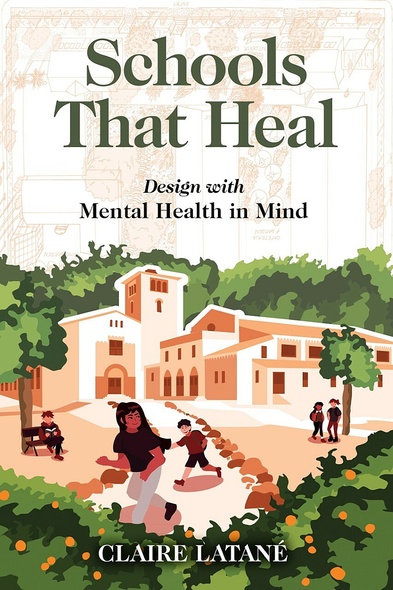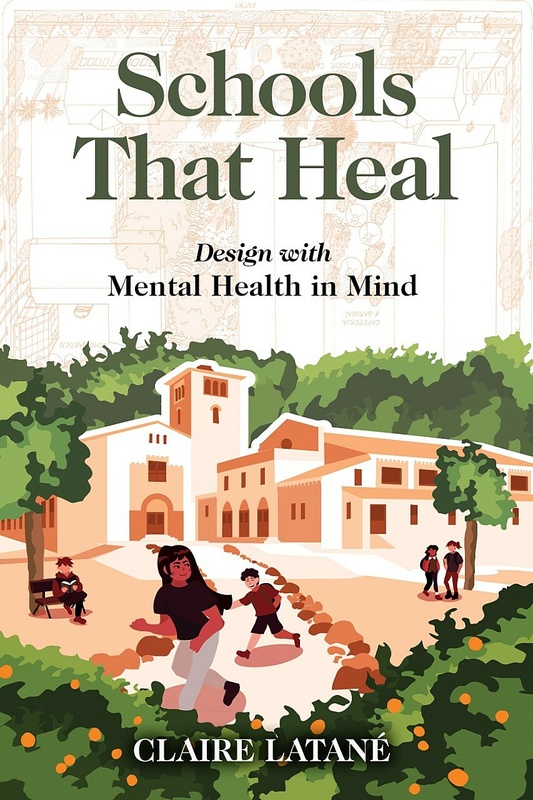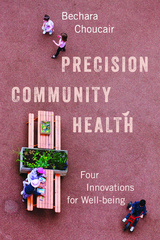What would a school look like if it was designed with mental health in mind? Too many public schools look and feel like prisons, designed out of fear of vandalism and truancy. But we know that nurturing environments are better for learning. Research consistently shows that access to nature, big classroom windows, and open campuses reduce stress, anxiety, disorderly conduct, and crime, and improve academic performance. But too few school designers and decision-makers apply this research to create healthy schools. Schools That Heal details the myriad opportunities—from furniture to classroom improvements to whole campus renovations—to make supportive learning environments for our children and teenagers.
Schools around the world have been designed to support students’ health. A Japanese community decimated by a tsunami has incorporated water elements into the school campus to reconnect students to nature in a supportive way and promote environmental stewardship. Sandy Hook Elementary, creating a completely redesigned campus in the wake of a school shooting, began with an inclusive design process to ensure the new school could be a place of healing and learning. And while the larger mental and physical impacts of how COVID-19 has changed schooling aren’t known yet, Latané discusses how building elements like large windows—that can open to circulate fresh air—were once common in schools and could once again be useful as a cost-effective tactic for reducing virus exposure.
Backed by decades of research, Schools That Heal showcases clear and compelling ways to create schools that support students’ mental health and feelings of safety. Written in an accessible tone, this book reviews the evidence connecting design to mental health and makes design and advocacy recommendations to support students’ well-being and sense of safety.
With invaluable advice for school administrators, public health experts, teachers, and parents, Schools That Heal is a call to action and a practical resource to envision and implement nurturing and inspiring school environments. Healthy, healing campuses will better prepare students to take care of themselves, their communities, their cities, and their planet.
Schools around the world have been designed to support students’ health. A Japanese community decimated by a tsunami has incorporated water elements into the school campus to reconnect students to nature in a supportive way and promote environmental stewardship. Sandy Hook Elementary, creating a completely redesigned campus in the wake of a school shooting, began with an inclusive design process to ensure the new school could be a place of healing and learning. And while the larger mental and physical impacts of how COVID-19 has changed schooling aren’t known yet, Latané discusses how building elements like large windows—that can open to circulate fresh air—were once common in schools and could once again be useful as a cost-effective tactic for reducing virus exposure.
Backed by decades of research, Schools That Heal showcases clear and compelling ways to create schools that support students’ mental health and feelings of safety. Written in an accessible tone, this book reviews the evidence connecting design to mental health and makes design and advocacy recommendations to support students’ well-being and sense of safety.
With invaluable advice for school administrators, public health experts, teachers, and parents, Schools That Heal is a call to action and a practical resource to envision and implement nurturing and inspiring school environments. Healthy, healing campuses will better prepare students to take care of themselves, their communities, their cities, and their planet.
Backed by decades of research, Schools That Heal showcases clear and compelling ways to create schools that support students’ mental health and feelings of safety. Written in an accessible tone, this book reviews the evidence connecting design to mental health and makes design and advocacy recommendations to support students’ well-being and sense of safety….The important advantage of the book is that it presents the landscape architecture of schools in a broader context of environmental, cultural, economic and management issues of schools.’
Latané's thorough and fascinating work on designing for student mental health leads us to the natural world, a place with infinite power to soothe and uplift everyone who engages with it. Both poetic and practical, this book examines every facet of this movement, all supported by research and results from environmental psychologists, educators, families, and students. The outcome is a compelling case for nature-driven planning and design.
What timely help is found in Schools that Heal! Educators are under tremendous pressure to compensate children for the educational, social, and emotional hardships amplified by the global pandemic. This book is a must-read guide to ways that school communities can rethink and redo the indoor and outdoor environments of our schools to support student, staff, and community healing and well-being.
Claire Latané is a landscape architecture professor at California State Polytechnic University in Pomona (Cal Poly Pomona). Her teaching and scholarship apply research connecting the mind, body, and environment to design places and processes that support mental health. Claire has practiced landscape architecture for 14 years. She has designed interactive environments for elementary schools, middle schools, high schools, colleges, and universities as well as for affordable housing communities and public parks. Claire lives in Los Angeles, where her own garden is an experiment on what will grow wild with little care but lots of love.
Foreword by Manal J. Aboelata
Preface
Chapter 1: Nine Reasons Why We Should Design Schools with Mental Health in Mind
Chapter 2: How School Environments Shape Mental, Social, and Physical Health
Chapter 3: Site Design Strategies to Support Mental Health, Safety, and Well-being
Chapter 4: Leveraging Schools for Public Health, Equity, and Climate Resilience
Chapter 5: How to Communicate for the Best Chance at Change
Chapter 6: Money Doesn’t Grow on Trees … Or Does It?
Chapter 7: Ten Schools to Inspire and Guide You
Chapter 8: Conversations on Transformation by Design
Chapter 9: For the Love of Students
Resources
Notes
Acknowledgments
About the Author
Index
Preface
Chapter 1: Nine Reasons Why We Should Design Schools with Mental Health in Mind
Chapter 2: How School Environments Shape Mental, Social, and Physical Health
Chapter 3: Site Design Strategies to Support Mental Health, Safety, and Well-being
Chapter 4: Leveraging Schools for Public Health, Equity, and Climate Resilience
Chapter 5: How to Communicate for the Best Chance at Change
Chapter 6: Money Doesn’t Grow on Trees … Or Does It?
Chapter 7: Ten Schools to Inspire and Guide You
Chapter 8: Conversations on Transformation by Design
Chapter 9: For the Love of Students
Resources
Notes
Acknowledgments
About the Author
Index







